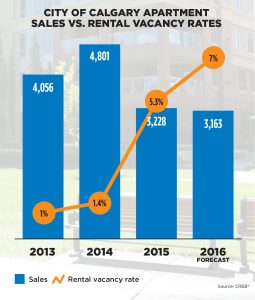
Some industry officials believe the the city’s rental vacancy rate may already have hit seven per cent – or even higher. CREB®Now file photo
July 22, 2016 | Barb Livingstone
A tenants' market
Apartment sector creating dream scenario for renters, say expertsCalgary's buyers' market for an increasing inventory of apartment-style condos is also translating into one of the best renters' market in recent history, according to new statistics from Canada's housing agency.
And an already-rising supply of apartments for rent, due to the city's economic slump, is expected to jump even further this year.
The 30 per cent of apartment condos traditionally bought by investors to offer for rent will combine with new rental-only units being built to push Calgary's rental vacancy rate to seven per cent by this October, according to Canada Mortgage and Housing Corp. (CMHC).
The head of the association representing the residential rental industry, however, says the city's vacancy rate may already have hit seven per cent – or even higher.
That compares to 5.3 per cent in October 2015 and 1.4 per cent in fall 2014.
In 2013, the vacancy rate was just one per cent.
Meanwhile, the City of Calgary released its 2016 census earlier this week, revealing that the vacancy rate for dwellings in April increased to a 16-year high. The City reported 20,800 units were empty in April, a 67 per cent jump from the same time last year. That put the city's vacancy rate at 4.3 per cent, it's highest since 2000.

The City bases its vacancy rate on the percentage of all dwellings that are available to be occupied that are not currently occupied, regardless of whether they are available for rent or not.
Richard Cho, senior market analyst in Calgary for CMHC's Prairie region, noted vacancy rates this year have generally been on the decline, with some areas of the city and sectors of the industry being more impacted that others. For example, he noted there were 6,196 apartment condominiums already under construction in March this year – almost one-third of which will likely be investor owned and become part of the secondary rental market when completed. By June, that number had jumped to 7,225 (with a concentration in the southeast, northwest and the Beltline), with just 237 new apartment condo starts in that month.
Cho noted continued construction in the apartment sector, in particular, means both buyers and renters will have more choice in where to live – especially in the current economic downturn where both employment and in-migration have declined.
"The seven per cent is well above what we typically see. That means more options, more deals," said Cho.
Calgary Residential Rental Association executive director Gerry Baxter suggested vacancies in some areas of the city are even higher than what CMHC is projecting.
"Some companies, with the larger towers, could see vacancies of 15 to 25 per cent," said Baxter, whose organization represents owners of about 65,000 rental units in the city that range from small investors to large companies.
Overall, he said the vacancy rate could already be between seven and 10 per cent. Baxter noted most of the apartment rentals in Calgary are located downtown and in the Beltline.
As part of Calgary's homebuilding industry, Baxter said the rental accommodation sector is used to the cyclical nature of its business.
However, given the combination of a more robust investor market and the flurry of purpose-built rentals — a sector that had been stagnant in Calgary for some years until the last three years of strong build — "we have not seen anything like this in recent memory. It is truly a tenants' market."
Baxter added the current situation means many landlords have been forced to lower rents and/or offer additional incentives such as free cable and utilities to attract would-
be renters.
CREB® statistics reveal the same continued lag in the apartment resale market that is similarly reflected in other multi-family resale sectors. While June was the busiest the city has seen in 11 months with 311 apartment sales, overall activity in the sector was still down, year over year, by 22 per cent.
CREB® chief economist Ann-Marie Lurie said rising vacancy rates will naturally place downward pressure on rental rates.
She also echoed Cho's comments that, moving forward, new rental apartment buildings will join continued ownership product offered for rent to keep vacancies elevated and rents on the downward trend.
CMHC forecasts rents will drop to an average $1,270 for a two-bedroom apartment by October this year, compared to $1,332 in October 2015.
Cho expects the vacancy rate will improve to 5.5 per cent by fall of 2017, with a "modest" improvement in employment and net migration.
However, because the rate will continue to be well above historical norms, CMHC predicts continued pressure on landlords will see a further reduction in average rents to $1,260 by October next year, for that same two-bedroom unit.
Baxter agreed there will be little improvement for landlords until at least 2017, especially when apartment owners not only face stiff competition for renters, but also high turnover and higher operating costs.
"It is bad this year, and maybe won't be as bad next year, but it will not be a turnaround," he said.
Tagged: Uncategorized




